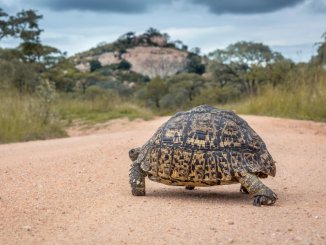The river cooter (Pseudemys concinna) is a turtle of the Emydidae family, found in the rivers of the southern and eastern portions of America, particularly from Virginia, down to Florida, and up to eastern Texas.
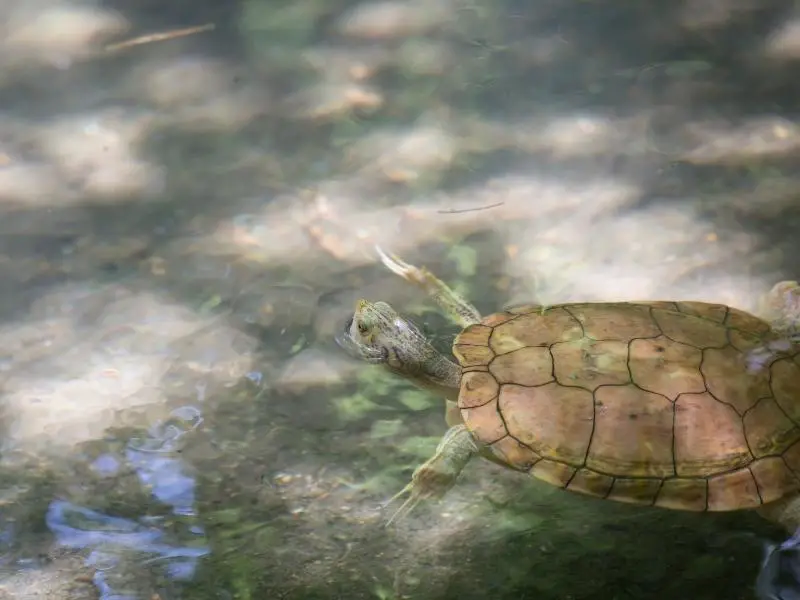
The river cooter is a freshwater species that is large in size, with a carapace (shell) that measures up to 16 inches (42 cm) in length.
The river cooter has a gentle, quiet nature that makes this turtle a good pet.
River Cooter Overview
| Common Name: | River cooter |
| Scientific Name: | Pseudemys concinna |
| Natural Habitat: | Lakes, rivers, ponds, tidal marshes in the eastern and southern parts of the United States |
| Adult Size: | 16.5 inches (42 cm) |
| Average Lifespan: | 40 years |
| Diet: | Herbivore, algivore, carnivore |
| Housing: | 100-gallon aquarium with play sand and river rock substrates. Temperature 90–95°F for adults. Lighting with UVB 150 watts during the day and dark at night |
| Experience Level: | Beginner |
Origin
The river cooter derives its name from the African word “kuta,” which means “turtle.” River cooters may have originated during the Pleistocene period in Georgia, Florida, South Carolina, Alabama, Indiana, and Kansas, as shown by fossil remains discovered there.
At present, river cooters are commonly found in lakes, rivers, and marshes in the eastern and southern parts of America, particularly in the states of West Virginia, Virginia, Texas, Tennessee, South Carolina, Pennsylvania, Oklahoma, Ohio, North Carolina, Missouri, Alabama, Arkansas, Florida, Georgia, Illinois, Indiana, Kansas, Kentucky, Louisiana, and Mississippi, and sometimes Maryland.
River cooters are usually seen in flowing, shallow water, such as streams, with depths of around 6 feet (2 m). These turtles usually prefer areas with lush aquatic vegetation and wide areas that can be used for basking.
River cooters are most active during warmer seasons, as it is during spring and summer when nesting mostly takes place.
Appearance and Behavior
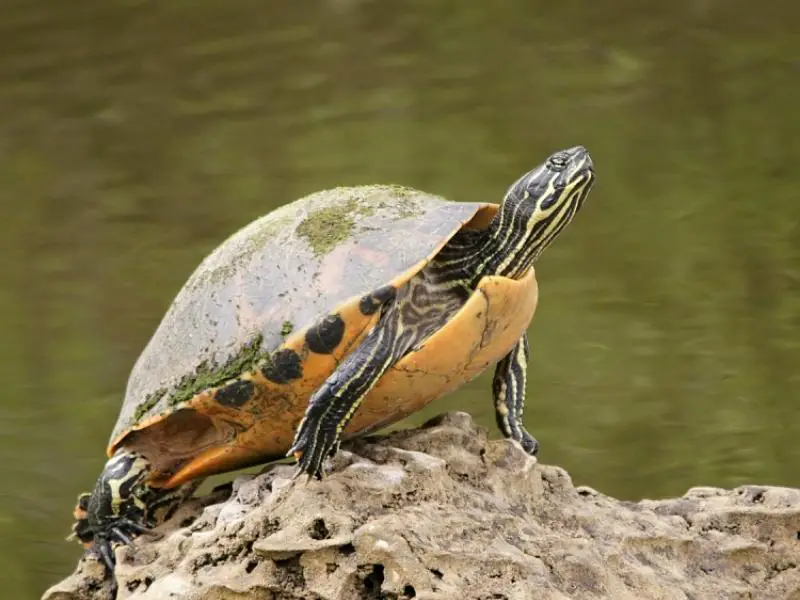
Besides their large size, females tend to have a slightly higher profile than males. The bottom surface of the females’ shell, known as the plastron, is more convex than the males’.
The male river cooter’s tale tends to be longer and thicker compared to that of the female’s, and the male’s foreclaws are more elongated.
The river cooter’s head is marked with yellow stripes. There are also lines that run along its lips, and stripes in well-arranged branching or straight patterns can also be seen along its forelegs.
The river cooter’s carapace has a dark greenish-brown color, usually marked with a “C” near the posterior. The plastron takes on a yellow to a bright reddish-orange color.
Dark lines, or patterns, serve as a mark or boundary between each scute. These dark areas tend to fade as the turtle ages.
River cooters have large, webbed feet, which account for their speed when swimming.
Size and Lifespan
River cooters are big turtles. Male river cooters can grow up to 16 inches (42 cm) in length, while the females grow slightly smaller, reaching up to 12 inches (30 cm).
River cooters can live up to an average of 40 years, or even longer when in captivity.
Temperament
River cooters are quiet and gentle by nature. They are fast swimmers, and they can get around easily on land as well.
The turtles like to bask in groups, piled on top of each other in areas that are exposed to sunlight. River cooters like to bask on objects such as rocks or wooden trunks.
River cooters are diurnal, meaning that they do most of their activities in the daytime and rest at night. They like to sleep hidden underneath aquatic plants.
They bask and forage for food during the day.
During basking, river cooters stay in warm spots to absorb as much sunlight as they can. Any disturbance in the water automatically sets them scrambling away from their basking spots.
River cooters are most active during the summer months. They may become dormant, hiding in the mud for as long as two months underwater in colder seasons.
In their natural habitat, river cooters seldom leave the areas they have grown accustomed to. They are known to stay in one area until they die.
Housing River Cooters
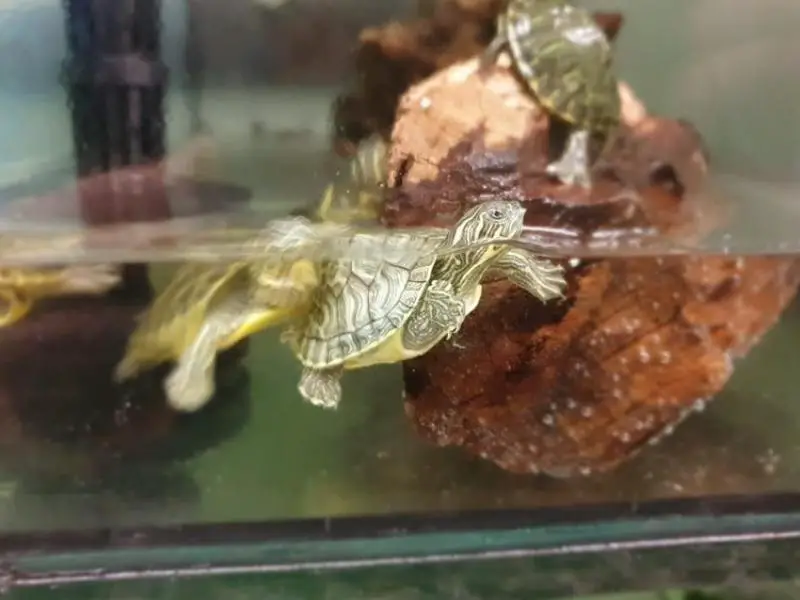
River cooters are used to habitats with shallow water, sandy or silty bottom substrates, and lush vegetation.
They enjoy moving between bodies of water and sunny basking spots on land. You should mimic these environments in the turtle’s captive enclosure.
To simulate the river cooter’s natural habitat, an acrylic or glass aquarium with a capacity of at least 100 gallons is recommended.
The large aquarium should be big enough to accommodate a full-grown river cooter – this turtle can grow to be quite large.
A pond or large fiberglass kiddie pool can serve as a good alternative for housing a river cooter.
Sandy substrates can be used with the housing, and be sure to place many aquatic plants for the turtle to sleep in.
Decorations like driftwood may be placed in the enclosure, but only to a minimum, especially if there are plans to breed the river cooters, since breeding requires extra open space.
Provide a platform-like area in the turtle’s enclosure where the turtle can bask, since basking is one of its greatest habits.
The temperature in the enclosure’s basking area should be around 85°F.
Enclosure size
Although there are no set size requirements for the river cooter’s enclosure, an ideal size is approximately 48 x 24 x 12 inches – this provides ample space for the cooter to feel comfortable.
Lighting
Lighting should simulate normal night and day cycles. Provide at least 12 hours of light during the day, and turn the lights off during nighttime.
It is essential that river cooters be exposed to ample amounts of UVB (150 watts) for the turtle to synthesize Vitamin D3, which is necessary for its bone maintenance.
Be sure to use a lamp that has the required UVB for each specific age group.
Lighting requirements are as follows:
- Hatchlings – 75 watts UVB
- Juveniles – 100 watts UVB
- Adults – 150 watts UVB
- 10–12 hours of lighting, and lights off at night
Temperature and Humidity
Water temperatures in the river cooter’s enclosure should be set at around 75°F, while the temperature at the basking site should be set to between 85–90°F. Use heat lamps for the basking site to ensure that basking temperatures are met.
When taking care of baby river cooters, warmer temperatures are needed. Baby river rooters thrive at 80˚F (27˚C). Place heating pads underneath the aquarium to maintain this temperature.
River cooters thrive under humid conditions, so the turtle’s enclosure humidity should be kept at 70%–80%.
Having enough water in the tank – that is, having it filled up to around 2/3 of its capacity – is one way to ensure that the humidity level is kept at an ideal level.
Substrate and Decoration
The best substrate for river cooter turtles is sand, or pebbles that are too large for the turtle to ingest.
Rocky substrates are the easiest to maintain, although care should be taken that pieces are not small enough for the river cooters to ingest.
Sandy substrates best simulate the river cooter’s natural environment. Sand can become dirty faster than rocky substrates, so replace sand frequently to keep the enclosure clean.
Decorations, like pieces of driftwood and plastic decors, are optional and should be kept at a minimum, especially when baby river cooters are in the housing.
Decorations with tight holes may entrap baby river cooters and cause harm, injury, and even death.
Cleaning
Cleaning the river cooter’s tank is necessary to keep the turtle healthy and free from disease.
- Before cleaning the enclosure, move the river cooter to another tank or container
- Remove all the contents from the enclosure, including substrates, plants, decorations, and food
- Disinfect the bottom and walls of the enclosure using warm water mixed with bleach using this proportion: ½ cup of bleach to every one gallon of water
- Leave the cleaning solution in the enclosure for approximately ten minutes and then rinse. Leave the enclosure to air-dry
- Clean all decorations and rocks by running them through tap water, and leave to air-dry
- When the enclosure and decorations are dry, refill the enclosure with fresh substrate. Put all the decorations and rocks back into the enclosure. Return the river cooters to the enclosure
It’s important that gloves be worn when handling river cooters. If gloves aren’t available, make sure to wash your hands thoroughly right after handling the river cooters.
River cooters may harbor salmonella, which can cause disease in humans through ingenstion.
Part of keeping the turtle’s enclosure clean includes the use of water filters to keep the water clean. Unfiltered water may harbor bacteria and viruses, which may cause disease in your river cooter.
As a general rule, it’s recommended that cleaning be done at least twice a month.
River Cooter Care
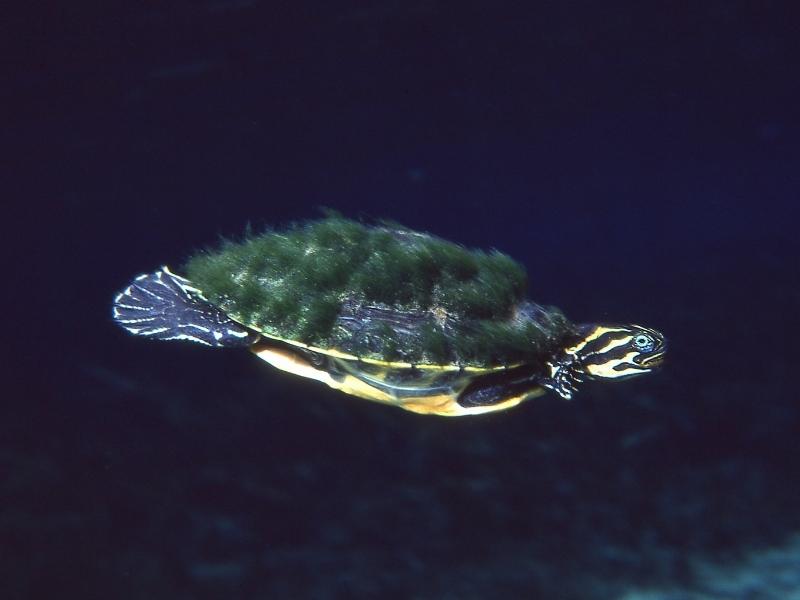
River cooters are easy to care for, given their gentle temperament and low maintenance needs.
Food and Water
When the river cooter is young, it eats meats like small fish, crayfish, bugs, and worms. As the turtle matures, it evolves to be an herbivore and thrives mostly on aquatic plants.
You may also feed adult river cooters other greens like lettuce, which they can easily digest.
Adult river cooters are fed three times a week, and hatchlings should be given food every day.
While river cooters get their food from dry spots, they have difficulty swallowing their food without water.
Once they get hold of their food, they get back into the water to swallow the food along with some water from their surroundings.
Common Health Issues
Metabolic bone disease is common in turtles that lack exposure to sunlight. Metabolic bone disease may result in deformities, and bones that are prone to fracture.
Exposing the turtle to the required amount of UV light is necessary to prevent this disease.
Unhygienic conditions, such as poorly maintained housing, can lead to several kinds of bacterial and fungal diseases in river cooters. Clean and maintain the turtle’s enclosure regularly to keep the turtle healthy.
Parasitic infections are usually detected in river cooters through routine check-ups, unless the disease is respiratory in nature. In any case, it is best to bring the turtle to a veterinarian for diagnosis.
Proper medications, such as antifungals and antibiotics, will be prescribed depending on the nature of the infection.
Breeding

River cooters mate during the spring. The mating process begins with a phenomenon known as the “mating dance.”
The male river cooter mounts the female during the mating dance right after it detects the scent hormone, known as pheromones, from the female’s tail.
While the male swims on top of the female and attempts insemination, he simultaneously strokes the female’s face using his claws.
Once insemination is successful, the female looks for an area where she can nest. She digs a hole in the substrate where she lays her eggs.
Incubation takes place anywhere between 90–100 days in ideal temperatures of 84˚F. River cooter eggs hatch on their own.
If bred in captivity, the baby turtles should be transferred to another tank as soon as they hatch from their eggs, and the babies’ new tank should meet the optimum temperature of 84˚F and lighting requirements of UVB 150 watts.
Choosing and Buying a River Cooter
River cooters cost between $30–$100. These turtles are not rare, nor are they uncommon. they’re easily found at any pet store or online store.
When buying a river cooter, make sure to look out for these signs to make sure that you are buying a healthy river cooter:
- Bright eyes, with eyelids that aren’t puffy
- Absence of wheezing sounds when breathing
- Appear to have strong limbs when handled or carried
- Should appear to be balanced when swimming
- Absence of wounds on the skin and no cracks on the shell
If buying from a pet store, make sure to check the turtle’s enclosure, making sure that it is properly maintained. A badly-maintained habitat can signal that the turtle might have several infections due to injuries.
Buy river cooters only from reputable breeders and dealers to ensure that you are getting a river cooter that has been properly looked after and bred.


